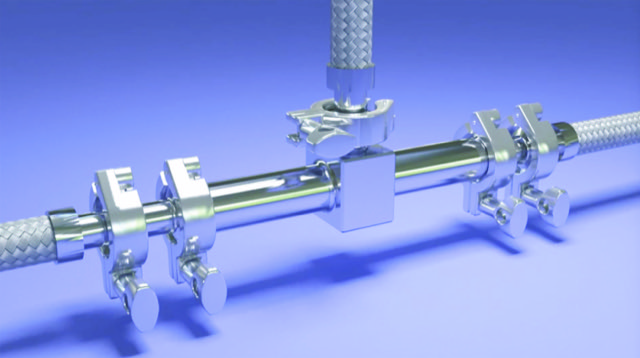
Feature article: Removing a bottleneck to 21st century manufacturing formulation
Submitted by:
Andrew Warmington
Dai Hayward and Dave Palmer of Micropore present a new technology that can provide an alternative to traditional homogenisation by mechanical mixing.
As the demand for formulating products becomes increasingly sophisticated, particularly in industries such as biopharmaceuticals, new technologies are required to replace methods for blending products at a manufacturing scale that are still based on principles of homogenisation by mechanical mixing that were first developed over 100 years ago.
Although there have been refinements in the technique, mechanical mixing is still built upon the basic process that 19th century engineers would still recognise. A rapidly spinning blade is used to ‘break up’ the disperse phase substance into the continuous phase. This approach to forming emulsions is fundamentally aggressive and difficult to control. In technical terms, it takes significant energy and results in a formulation with broad particle size distribution and the possibility of a high proportion of particles within the formulation being damaged if ingredients are in any way delicate.
Over recent years, the development of microfluidic techniques, where the size of each droplet being ‘dripped’ into a mixture can be precisely controlled to give almost perfect monodispersity, has provided an alternative for the manufacture of high-quality emulsions. However, even when using multiple parallel microfluidic devices, the technique still cannot deliver industrially meaningful volumes.
In the 1980s, Nakashima and Shimizu developed the concept of creating emulsions by forcing one substance through a membrane into another substance. Over the years the proven application of this technique in multiple formulations has been thoroughly peer-reviewed in lab-scale batches. However, although achieving narrow size distribution at higher throughputs appeared to be a possibility, early embodiments of higher throughput membrane emulsification were plagued with problems because the membranes tested, made of glass or ceramics, were prone to fouling and blockages.
In the 1990s two UK academics took a different approach by experimenting with alternative membrane materials. Professor Richard Holdich and Dr Iain Cumming, of the Chemical Engineering department at Loughborough University, believed that the drawbacks of using glass or ceramic in a membrane emulsification process could be overcome through chemical engineering techniques utilising laser micro-drilled stainless-steel membranes to deliver near-monodisperse formulations at high throughputs.
Based on this work, Micropore Technologies was formed in 2003. Initially the company grew slowly as it established its credibility through demonstration of proof-of-principle studies working in partnership with blue-chip manufacturers. However, a scaled-up membrane emulsification technology took another 15 years to develop. In 2013, an initial functioning membrane emulsification device was developed, incorporating a laser micro-drilled stainless steel membrane.
This took manufacturing capacity from Micropore’s first bench-top device of 100 ml/batches up to 10kg/hour, with a coefficient of variation of 5-10%. Even so, this was still just a lab-scale development or pilot device capable of producing relatively modest quantities of product in batches. This equipment’s ability to control each variable parameter independently made it an ideal tool for formulation optimisation, but full-scale manufacturing-scale continuous production membrane emulsification unit was yet to be realised.
Working with long-term partner Williams Process, Micropore then set about developing a device that could deliver a narrow size distribution of around 10-20% at a volume of 1,000 tonnes/year of formulated product while meeting the needs of a manufacturing environment – sterile if needed – with robust ‘press button and walk away’ operation. The result was the launch of the company’s first high-throughput industrial scale crossflow devices in November 2017. The CXF-1, together with its aseptic GMP-compliant cousin, the AXF-1, enabled producers to make narrow size-distribution formulations in volumes of 20kg-1,500 tonnes/year for the first time.
Further scaling-up of throughputs followed, with the launch of the AXF-7 device in June 2019. This next generation of equipment was able to deliver the same 15-20% coefficient of variation performance of the AXF-1 but now with a throughput capacity of up to 15,000 tonnes/year, with the possibility of further scale-up by installing multiple devices in parallel. T
he benefits of a highly tuneable and less aggressive, high throughput membrane emulsification technology delivered through compact low energy equipment vary from market sector to market sector but are founded upon three fundamental attributes:
* Narrow particle size distribution
* A gentle process capable of efficiently processing delicate ingredients
* Low energy input through precision engineering
A specific example that illustrates the potential that this represents is injectable pharmaceuticals. One of Micropore’s pharma customers has described its drive to move from traditional homogenisation to membrane emulsification. In order to achieve the correct size distribution, this company historically discarded at least 30% of its initial production, which could not be recycled. In addition, the peptide it formulates is susceptible to high shear. As a result, traditional homogenisation typically destroyed 50% of the product through high-energy degradation of the peptide bond.
By contrast, the new technology is able to deliver 92-92% viable product, with 100% in the correct size range, with significant economic benefits. Outlook The future of high throughput membrane emulsification looks very promising. It is anticipated that it will be of interest in producing emulsions, double emulsions and encapsulated formulations in applications including:
* Novel new food and beverage formulations like low fat chocolates
* Cosmetics, fragrances and skincare products with new performance characteristics and requiring fewer emulsification stabilisers
* Pigments and inks with enhanced performance properties
* Agrochemicals, animal feeds, nutraceuticals and insect repellents able to take greater advantage of delayed action formulations
For many decades, the default starting point for formulation has been traditional homogenisation because it has proved reliable robust and scalable, despite its drawbacks. Micropore’s new membrane emulsification technology, and its growing acceptance, now offers a viable alternative to this, effectively removing a significant production bottleneck for today’s product manufacturers.
CONTACT
Dai Hayward
CEO
Micropore Technologies Ltd.
+44 1642 43836
www.micropore.co.uk
